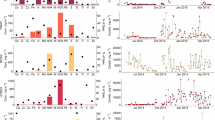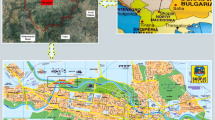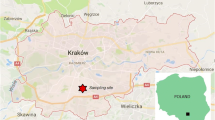Abstract
The mass concentration of PM2.5 fraction in the atmosphere of Krakow, Poland, is 2.6 times higher in winter than in summer. Similar observations were made for countries with very low temperature during cold season as discussed by Rogula Kozlowska et al. (Air Qual Atmos Health 7:41-58, 2014, Int J Environ Res Public Health 13:715, 2016), Jeong et al. (Atmos Pollut Res 2:158-171, 2011), and Zwozdziak et al. (J Aerosol Sci 103:38–52, 2017). Fossil fuel combustion for heating of individual households is mainly responsible for high air pollution levels in urban areas during winter season as reported by Junninen et al. (Environ Sci Technol 43:7964–7970, 2009). Elemental concentrations were determined by energy dispersive X-ray fluorescence method, whereas ion concentrations were measured by ion chromatography. In addition, concentrations of elemental carbon (EC) and organic carbon (OC) were determined using OC/EC analyzer. Some elements like Br, Pb and Cl−, NO3−, NH4+ ions show significantly higher concentrations during winter, whereas in summer, higher Ca concentration was observed. The positive matrix factorization (PMF) receptor method was used for identification of air pollution sources and evaluation of their contribution to PM2.5 burden in the local atmosphere. Selected chemical species were used as indicators of particular sources of air pollution. Four source categories were identified through PMF analysis: (i) combustion, (ii) secondary aerosols, (iii) soil/industry/traffic, and (iv) biomass burning. For days with high PM2.5 concentrations (winter season), the contribution of combustion sometimes reaching 55% of PM2.5 mass was identified, whereas for days with low PM2.5 concentrations, it was reduced to approximately 28%.





Similar content being viewed by others
References
Chalvatzaki E, Chatoutsidou SE, Lehtomaki H, Almeida SM, Eleftheriadis K, Hanninen O, Lazaridis M (2019) Characterization of human health risks from particulate air pollution in selected European cities. Atmosphere 10(2):96. https://doi.org/10.3390/atmos10020096
Chueinta W, Hopke PK, Paatero P (2000) Investigation of sources of atmospheric aerosol at urban and suburban residential areas in Thailand by positive matrix factorization. Atmos Environ 34:3319–3329
EEA Air Quality in Europe (2014) Report .European Environmental Agency Report No 5/2014, European Environment Agency EEA, Copenhagen
EEA Air Quality in Europe (2017) Report. European Environmental Agency Report No 13/2017, ISBN 978–92–9213-920-9, Luxembourg: Publications Office of the European Union
Jeong CH, McGuire ML, Herod D, Dann T, Dabek-Zlotoszynska E, Wang D, Ding L, Celo V, Mathieu D, Evans G (2011) Receptor model based identification of PM2.5 sources in Canadian cities. Atmos Pollut Res 2:158–171. https://doi.org/10.5094/APR.2011.021
Junninen H, Monster J, Rey M, Cancelinha J, Douglas K, Duane M, Forcina V, Muller A, Lagler F, Marelli L, Borowiak A, Niedzialek J, Paradiz B, Mira-Salama D, Jimenez J, Hansen U, Astorga C, Stanczyk K, Viana M, Querol X, Duvall R, Norris G, Tsakovski S, Wahlin P, Horak J, Larsen BR (2009) Quantifying the impact of residential heating on the urban air quality in a typical European coal combustion region. Environ Sci Technol 43:7964–7970. https://doi.org/10.1021/es8032082
Kabata Pendias A, Pendias H (1999) Biogeochemia pierwiastków śladowych. PWN, Warsaw (in Polish)
Karagulian F, Belis CA (2012) Enhancing source apportionment with receptor models to foster the air quality directive implementation. Int J Environ Pollut 50:190–196
Lammel G, Röhrl A, Schreiber H (2002) Atmospheric lead and bromine in Germany post-abatement levels, variabilities and trends. Environ Sci Pollut Res Int 9(6):397–404
Manousakas M, Papaefthymiou H, Diapouli E, Migliori A, Karydas AG, Bogdanovic-Radovic I, Eleftheriadis K (2017) Assessment of PM2.5 sources and their corresponding level of uncertainty in a coastal urban area using EPA PMF 5.0 enhanced diagnostics. Sci Total Environ 574:153–154. https://doi.org/10.1016/j.scitotenv.2016.09.047
Regulation of the Minister of the Environment (2012) on the levels of certain substances in the air. 24August 2012, Dz.U. 1031
Rogula Kozlowska W, Klejnowski K, Rogula Kopiec P, Mathews B, Szopa S (2012) A study on the seasonal mass closure of ambient fine and coarse dust in Zabrze, Poland. Bull Environ Contam Toxicol 88:722–729. https://doi.org/10.1007/s00128-012-0533-y
Rogula Kozlowska W, Klejnowski K, Rogula Kopiec P, Osrodka L, Krajny E, Blaszczak B, Mathews B (2014) Spatial and seasonal variability of the mass concentration and chemical composition of PM2.5 in Poland. Air Qual Atmos Health 7:41–58. https://doi.org/10.1007/s11869-013-0222-y
Rogula Kozlowska W, Majewski G, Blaszczak B, Klejnowski K, Rogula Kopiec P (2016) Origin-oriented elemental profile of fine ambient particulate matter in central European suburban conditions. Int J Environ Res Public Health 13:715. https://doi.org/10.3390/ijerph13070715
Samek L, Stegowski Z, Furman L (2016) Preliminary PM2.5 and PM10 fractions source apportionment complemented by statistical accuracy determination. Nukleonika 61(1):75–83
Samek L, Stegowski Z, Furman L, Fiedor J (2017a) Chemical content and estimated sources of fine fraction of particulate matter collected in Krakow. Air Qual Atmos Health 10(1):47–52. https://doi.org/10.1007/s11869-016-0407-2
Samek L, Stegowski Z, Furman L, Styszko K, Szramowiat K, Fiedor J (2017b) Quantitative assessment of PM2.5 sources and their seasonal variation in Krakow. Water Air Soil Pollut 228:290. https://doi.org/10.1007/s11270-017-3483-5
Samek L, Stegowski Z, Styszko K, Furman L, Fiedor J (2018) Seasonal contribution of assessed sources to submicron and fine particulate matter in a central European urban area. Environ Pollut 241:406–411. https://doi.org/10.1016/j.envpol.2018.05.082
Styszko K, Szramowiat K, Kistler M, Kasper-Giebl A, Samek L, Furman L, Pacyna J, Gołaś J (2015) Mercury in atmospheric aerosols: a preliminary case study for the city of Krakow, Poland. Comptes Rendus Chimie 18(10):1183–1191
The European Parliament and the Council of the European Union Directive 2008/50/EC of the European Parliament and the Council of 21 May 2008: On ambient air quality and cleaner air for Europe. [(accessed on 11 June 2008)] Available online: http://eur-lex.europa.eu/LexUriServ/LexUriServ.do?uri=OJ:L:2008:152:0001:0044:en:PDF
Vallius M, Janssen NA, Heinrich J, Hoek G, Runskane J, Cyryl J, Van Grieken R (2005) Sources and elemental composition of ambient PM2.5 in three European cities. Sci Total Environ 337:147–162
Voivodship Inspectorate of Environmental Protection in Krakow Report on Environmental Pollution in Malopolska Region, Krakow, 2013
Voivodship Inspectorate of Environmental Protection in Krakow Report on Environmental Pollution in Malopolska Region, Krakow, 2018
Zwozdziak A, Gini MI, Samek L, Rogula-Kozłowska W, Sowka I, Eleftheriadis K (2017) Implications of the aerosol size distribution modal structure of trace and major elements on human exposure, inhaled dose and relevance to the PM2.5 and PM10 metrics in a European pollution hotspot urban area. J Aerosol Sci 103:38–52. https://doi.org/10.1016/j.jaerosci.2016.10.004
Funding
This research has been supported by the National Science Center Project No DEC-2016/21/B/NZ7/01747.
Author information
Authors and Affiliations
Corresponding author
Additional information
Publisher’s note
Springer Nature remains neutral with regard to jurisdictional claims in published maps and institutional affiliations.
Rights and permissions
About this article
Cite this article
Samek, L., Stegowski, Z., Styszko, K. et al. Seasonal variations of chemical composition of PM2.5 fraction in the urban area of Krakow, Poland: PMF source attribution. Air Qual Atmos Health 13, 89–96 (2020). https://doi.org/10.1007/s11869-019-00773-x
Received:
Accepted:
Published:
Issue Date:
DOI: https://doi.org/10.1007/s11869-019-00773-x




